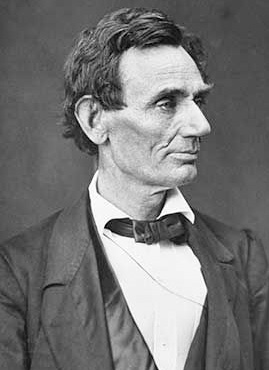Today is the 146th birthday of the state of West Virginia. I thought I'd mark the anniversary by recounting a brief history of the state, explain Abraham Lincoln's involvement with it, and discuss the statue pictured here.
The vast majority of the citizens of what was then western Virginia did not approve of secession from the U.S in 1861. They were culturally, politically, and even economically different from the rest of Virginians. The western counties did not depend nearly as heavily on slavery as did the rest of the state, thanks primarily to topography. Western (West) Virginia is mountainous and rugged, and there were no plantations or even huge scale farms as there were in the central and eastern regions of Virginia. As part of the agreement to enter the Union as a new state, this breakaway region of Virginia had to agree to abolish slavery, which it did at a state convention in the town of Wheeling.
It was Abraham Lincoln who signed on December 31, 1862 the Statehood Bill granting approval to western Virginians to seek admission to the Union. Less than six months later on June 20, 1863, the new state of West Virginia became the 35th admitted to the Union.
There were Civil War encounters in western (West) Virginia, including the site of the first land battle of the war in 1861, in the small town of Philippi. Union General George B. McClellan and Confederate General Robert E. Lee both saw action in western Virginia at the outset of the war. And what is now Harpers Ferry, West Virginia was the scene of the infamous John Brown raid on the Federal Arsenal on October 16, 1859. Even with fairly numerous battles and skirmishes throughout the Civil War, western (West) Virginia suffered much less throughout the war than did the heart of the Confederacy. For more information about the history of West Virginia, you may click on this article.
In 1974, the citizens (primarily children who collected pennies) of West Virginia erected the statue of Lincoln (pictured above) on the grounds of the state capitol in Charleston. West Virginia artist Bernie Wiepper based the statue on a famous poem "Abraham Lincoln Walks At Midnight", written by poet Vachel Lindsay. The Charleston (W.Va) Gazette-Mail newspaper contains more information about the statue here.
The poem on which the statue is based is very moving. It was originally published in 1914 at the onset of World War I, then known as The Great War. It depicts a melancholy Lincoln arisen from his eternal sleep, roaming Springfield, disturbed by yet another time of war in the world. The text of the poem may be found here.
p.s. - if you like what you read here or anywhere else on The Abraham Lincoln Blog, follow it on Twitter. I'll post other news about Lincoln there when I don't have the time for in-depth blog posts. Click here to begin following today!



2 comments:
really great statue but i myself would have added wings to show it symbolized lincolns ghost which if i am not mistaken was the point of the poem and this statue
Bernie was my Great Uncle, He was a caring and loving man!! He will be greatly missed by many!! The reason I am writing this is: His name is no where on the plaque of the statue.. He needs credit on it somewhere! They need to make a new one to include him on it!! He needs credit for what he did. The only credit that he has gotten for it was just on paper!! He was the one who really did the statue LINCOLN WALKS AT MIDNIGHT!!!!
Post a Comment